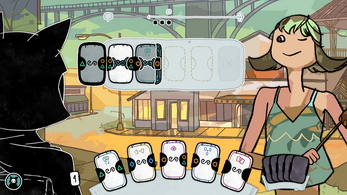Signs of Sojourner: Mixing Gameplay and Narrative in a cool way.
2022 July 04This year I started a Games Club with some friends. The four of us would play games from the Itch bundles, usually narrative games, and get together some weekend to discuss the games. This has been a super nice exercise, both to get some socialization during Covid times, as well as a chance to play smaller indie games. (I posted about another game I played in this games club before)
This time, I want to talk about "Signs of the Sojourner", a game which I liked quite a lot.
The idea of the game is that you are the owner of a shop at a small village, and you get to wander to nearby communities to find items to stock your store with.
The main drive of the game is the conversations you have with the characters at each community you visit. However, instead of talking to these characters through a dialog tree, the conversation happens through a card game. You and the character you are talking with play cards with different symbols. If the symbol agrees, the conversation tends to agreement, otherwise you and the other character won't find common ground, and the conversation will usually end in a somewhat hostile tone.
This is where the game tries to mix game mechanics and narrative. The most obvious is the "fatigue" card. When you travel for too long, you start to receive these "fatigue" cards, which don't match with anything. This tries to reflect how your character is too tired from travelling and becomes irritable.
In a more subtle way, every time you talk to somebody, you receive one of the cards that person used. Each area of the game tends to use more of one symbol of another, meaning that the more you visit one area, the more cards of that area will enter your deck, and the easier will be to talk to people in that area (and it will be harder to talk to people in other areas). This mimics a bit the idea of finding your social niche.
I really like how the game does a lot to integrate the mechanics and narrative. For example, which cards an NPC has also tends to reflect how accommodating that NPC is to strangers.
The game is not without its problems. The strategies for "succeeding" in conversations with NPCs are not very clear, and it is very easy to find yourself in a situation where you are failing almost all of the conversations. The game tries to imply through its text that it is okay to not agree with some people, but the interface and sound effects work against that most of the time. It also seems that the conversation options are either "enthusiastically agree" or "rudely shut down", with no clear way to politely disagree with what another character proposes.
Also, from a technical point of view, the game's Unity build has a very poor interaction with Wine, which means that it would lock me if I alt-tabbed away from it :-(
However, all in all I really liked this game, and I think this is a great experiment in trying to mix gameplay and narrative together.
The game also has several endings and sub branches. Although replaying it takes a bit too long, this means it can be a cool game to play in parallel with friends and discuss the different paths that each person took.
Tagged: #game-club, #gamedev, #gameplay, #interactive-fiction, #itch, #review, #signs-of-the-sojourner,
